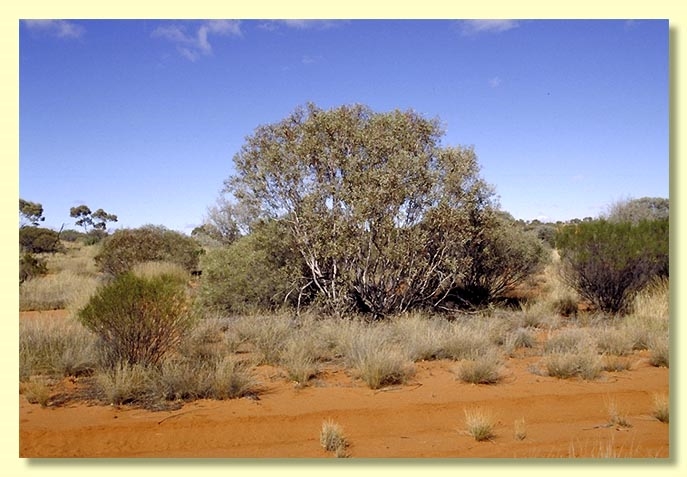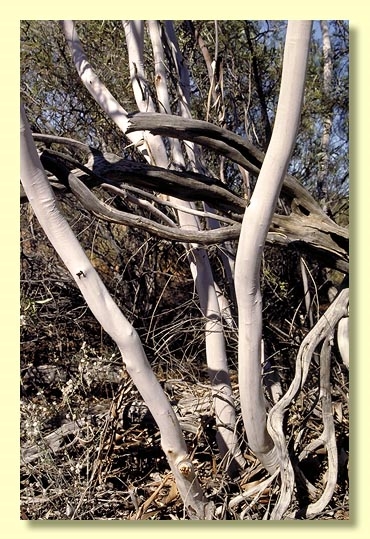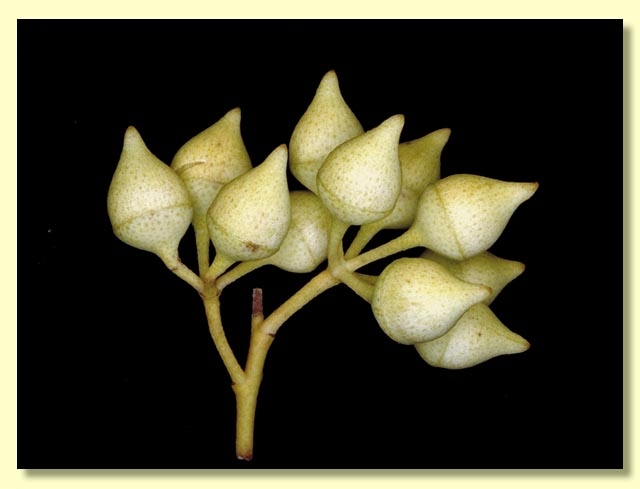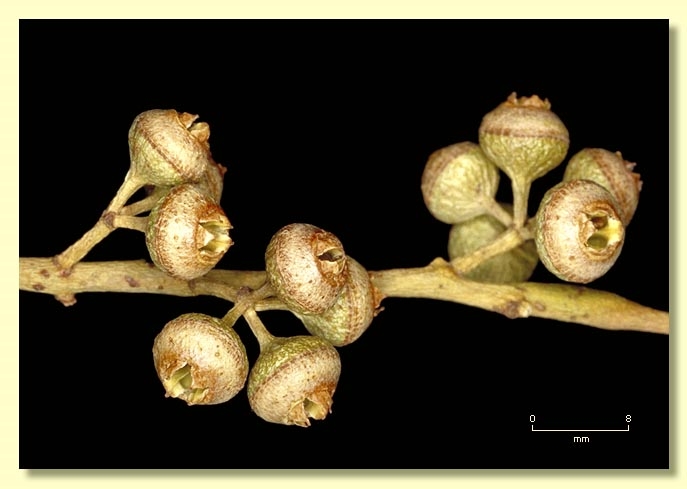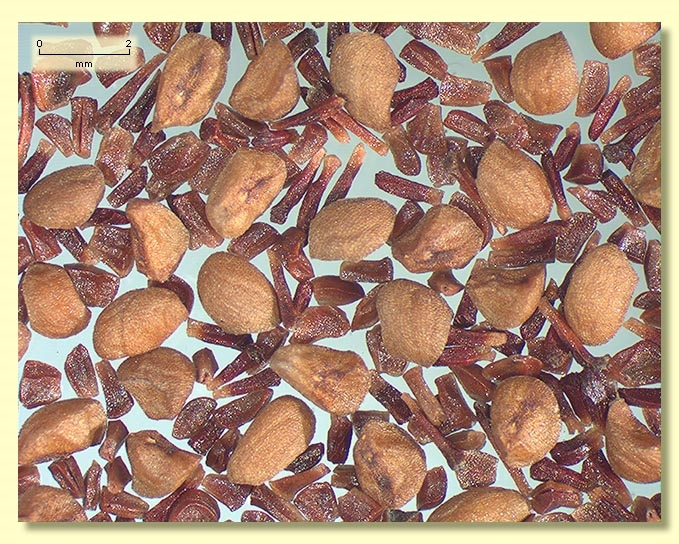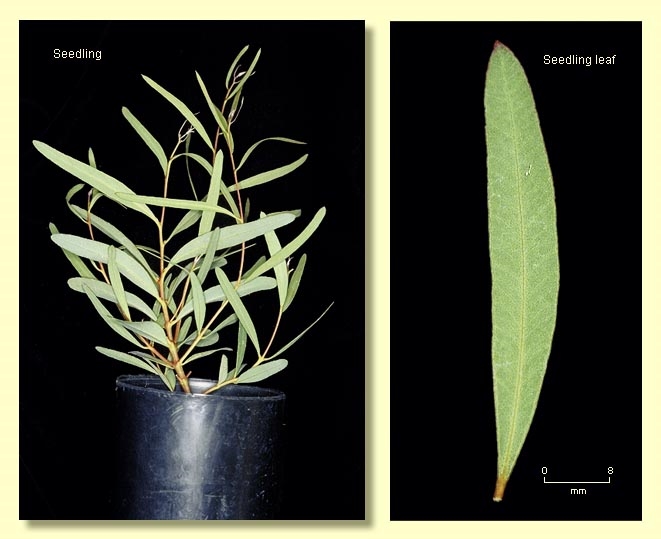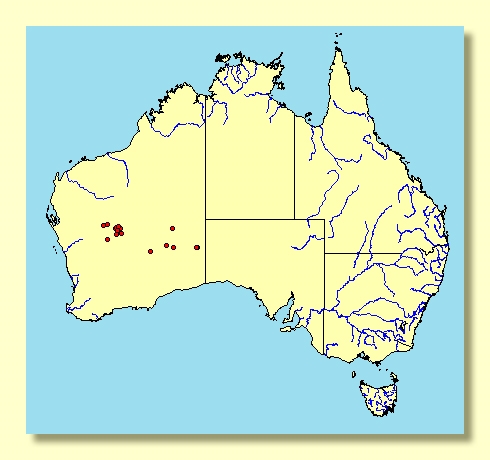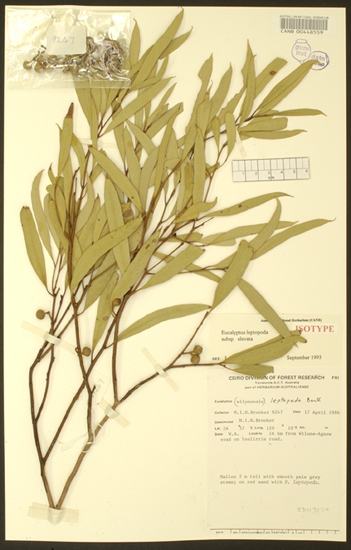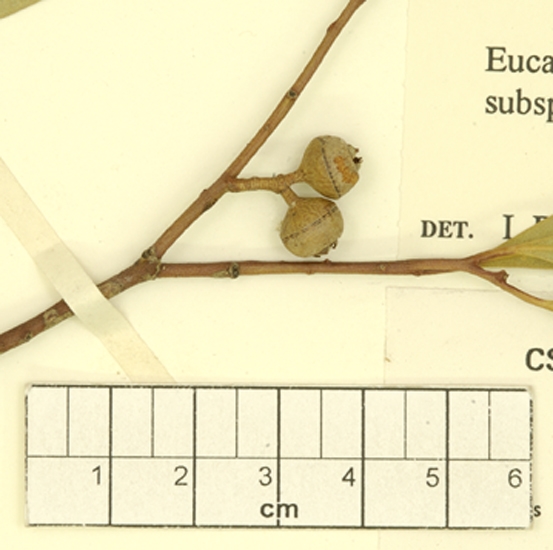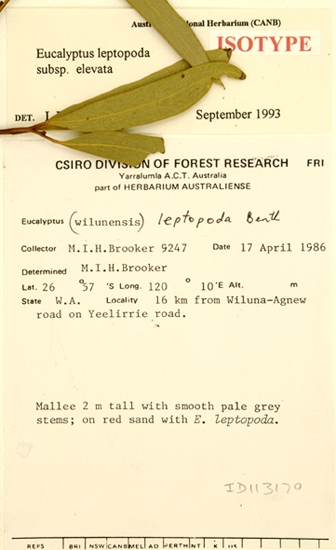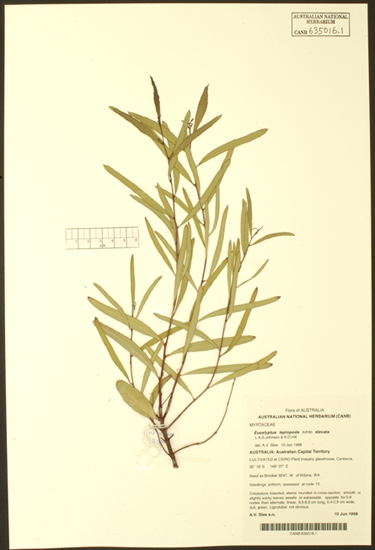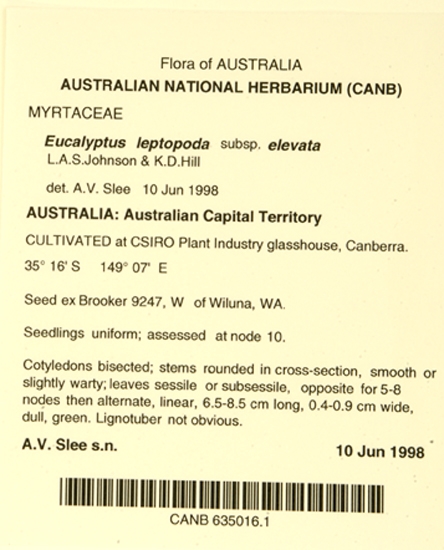Eucalyptus | Symphyomyrtus | Bisectae | Destitutae | Curviptera | Leptopodae
Euclid - Online edition
Eucalyptus leptopoda subsp. elevata
Bark smooth throughout, mottled red-brown to salmon pink and white, sometimes powdery.
Branchlets non-glaucous; lacking oil glands in the pith.
Juvenile growth (coppice or field seedlings to 50 cm): stems rounded in cross-section; juvenile leaves always shortly petiolate, alternate, linear to narrowly lanceolate, 4–8 cm long, 0.3–1.5(1.7) cm wide, green to grey-green, dull.
Adult leaves alternate, petioles 0.5–1.4 cm long; blade linear or narrowly lanceolate, (5)6.5–10.5 cm long, 0.5 –1.5 cm wide, base tapering to petiole, margin entire, apex pointed, concolorous, dull, grey-green to green, side-veins at an acute or wider angle to midrib, reticulation dense, intramarginal present, oil glands scattered, intersectional.
Inflorescence axillary unbranched, peduncles 0.6–1.3 cm long, buds usually 7 per umbel, pedicellate (pedicels 0.3–0.8 cm long). Mature buds ovoid to almost globular (0.75–1 cm long, 0.4–0.7 cm wide), scar present, operculum beaked (0.6–0.7 cm long), stamens erect or oblique, anthers cuboid to globoid, versatile, dorsifixed, dehiscing by longitudinal slits, style long and straight, stigma blunt to rounded, locules 4 or 5, the placentae each with 4 vertical rows of ovules with a long central gap to the placenta. Flowers creamy.
Fruit pedicellate (pedicels 0.2–0.6 cm long), hemispherical, 0.3–0.6 cm long, 0.6–1.3 cm wide, disc steeply raised and convex or oblique, valves 4 or 5, exserted.
Seeds brown, 1–2.5 mm long, angular ovoid to more or less flattened-ovoid, dorsal surface shallowly reticulate, hilum ventral to terminal.
Cultivated seedlings (measured at node 10): cotyledons Y-shaped (bisected); stems rounded in cross-section, non-glaucous; leaves sessile to very shortly petiolate, opposite for ca 5–8 nodes then alternate, linear, 4.5–9 cm long, 0.4–1 cm wide, dull, green to grey-green, intra-marginal vein present.
Flowering has been recorded in July, September and December.
Eucalyptus leptopoda is a mallee or small tree species, widespread in the central and northern wheatbelt of Western Australia east and north of Perth, extending into the goldfields and just into South Australia in the Great Victoria Desert; it is usually found on sand. The stems of the smaller mallees are smooth but the tree forms are usually rough at the base. The adult leaves are dull, light green to grey-green.
Eucalyptus leptopoda belongs in Eucalyptus subgenus Symphyomyrtus section Bisectae subsection Destitutae because buds have two opercula, cotyledons are Y-shaped and branchlets lack oil glands in the pith. Within this subsection E. leptopoda is in series Curviptera, one of about 30 closely related species and subspecies which are further characterised by having large buds in umbels of one, three or seven; staminal filaments erect or oblique (rarely inflexed) in bud; and large fruit usually with an ascending disc and exserted valves. Several of these species are noted for their large-leaved crowns made up of juvenile leaves.
E. leptopoda is unusual within series Curviptera because the fruit are not large like those of most related species but do have the typical broad ascending to flattened disc and exserted valves. The angular ovoid to slightly flattened-ovoid seeds are more like those of E. drummondii rather than being narrowly flanged and obscurely pyramidal as in most species in the series. Distinctive features of E. leptopoda are the linear spreading and more or less stiff adult leaves and the striking smooth white and red-brown bark.
There are four subspecies:
E. leptopoda subsp. leptopoda
Recognised by the flattish disc of the fruit and the bud numbers, rarely seven, usually 11 to 15. This form occurs from Cunderdin south-east to Hyden and north-east to Beacon and Kalgoorlie. In the eastern part of its distribution it seems to overlap with subsp. subluta and plants may not be easy to distinguish.
E. leptopoda subsp. arctata
The adult leaves are very narrow for the group and completely lack an intramarginal vein, the buds are usually in sevens and the disc of the fruit is prominently raised. The bark of large mallees or trees may be rough at the base. It occurs in the western part of the northern wheatbelt from the Murchison River area south-east to Koorda and inland to Paynes Find.
E. leptopoda subsp. elevata
The adult leaves are lanceolate, the buds in sevens and the disc of the fruit strongly raised. The bark of large mallees or trees may be rough at the base. It is distributed from Meekatharra and Sandstone in Western Australia extending east into the Great Victoria Desert to a point ca 80 km west of the Western Australia/South Australia State border.
E. leptopoda subsp. subluta
Leaves are linear to lanceolate, buds in sevens, and the disc of the fruit flat. Branchlets may be weakly pruinose. It occurs from east of Hyden to Burra Rock and north to Mt Jackson and Goongarrie Nature Reserve.
subsp. elevata: Latin elevatus, elevated, referring to the disc of the fruit.

